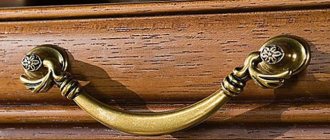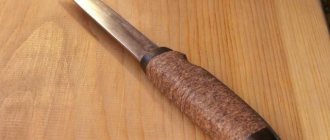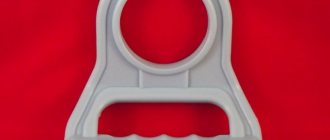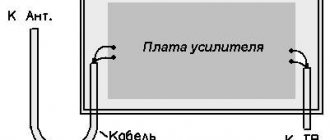Greetings, dear subscribers and readers. Today in our issue of “crazy hands” I will tell you how to assemble a cold thermonuclear fusion installation at home from shit and sticks and replace the ball joints with non-original ones from Mitsubishi Karizma/Speystar. Why from Karizma? It's simple. Ball bearings from Mazda and Kia require turning the ball body or boring the seat of the levers. Ball joints from Renault Logan require grinding of the adapter sleeve because... the body is much narrower. And only ball ones require practically nothing from Karizma, just a little.
The work can be done in two ways. Homemade vanilla, using a Dremel, chisel and hammer, 400 grams (the more the better). Or harsh garage BDSM fucking, using entrenching tools in the form of a sledgehammer, a pry bar and a chisel. I did one lever this way, the other that way, so I’ll tell you about both methods.
Method number one (home): You will need a grinder (optional), a Dremel (engraver) with a flexible drive and cutting diamond or carborundum discs (required), as well as a small chisel and hammer (the bigger the better). 1) Remove the lever. We bring it home, clean it, wash it. We remove the boot from the ball, pick out the shit from the ball. 2) Saw off the ball finger at the root. If you don’t do this and knock the ball out by hitting your finger, the ball joint will disperse the blow in all directions and you won’t be able to knock out the ball this way. This is why you need a grinder. Actually, you can saw it off with a Dremel, which is exactly what I sawed with it. The question is time. 3) Using an awl or scriber, draw a line along the weld seam, along the border of the ball and lever. 4) Take a Dremel and cut along the drawn line. To begin with, it is better to take a large reinforced carborundum disc and work with it, then switch to a small diamond one. The diamond cutting surface gets washed out quickly and cuts only so-so. 5) When the Dremel disk is immersed a third into the weld seam, you need to take a chisel and, using it and a hammer, cut the groove to be cut. Those. make it wider so that the Dremel disk, God forbid, does not bite into it. It is better to cut towards the shoulder of the ball joint so as not to shred the lever. 6) When we decide that it has been sawed and cut enough, try hitting the ball joint with a hammer. It’s better to do this not by weight, it’s of little use. You need to put something inelastic, a piece of rail or channel for example. 7) At a certain moment we will see that the ball began to come out of the lever. We look at where the welding is interfering with it and cut it there. So over several cycles we slowly knock the ball out of the lever. The time for everything about everything is from an hour or more.
Method number two (harsh garage): You will need a grinder, a sledgehammer and a hammer with a chisel. 1) Remove the lever, remove the boot from the ball, pick out the shit. 2) Use a grinder to saw off the ball finger at the root. So that the blow falls not on the ball, but on the ball body. 3) Using an awl or scriber, draw a line along the weld seam, along the border of the ball and lever. 4) Using a chisel, we cut the weld seam along the line in places where we can reach it and to a depth until we get tired of it. 5) Take the lever and place it on an anvil or other large iron ingot. It is important that the ball must be able to move down. And you shouldn’t substitute bricks and cinder blocks, I split the cinder block like that. It would be very good if someone had the opportunity to hold the lever. But lightly so as not to dry out your hands. But it’s fine without this, you just have to lift it every time. 6) Take a sledgehammer and hit the ball from above with all your heart. We look at the welding seam. In places where it has cracked, you can help it with a chisel. But if you have a lot of strength and a good sledgehammer, you don’t have to do this. In general, with a few blows, the welding seam bursts and the ball falls out. After all, welding works well in compression, but works poorly in tension.
Then everything is the same. 1) Remove the boot from the new ball joint and insert it into the lever, slightly helping with a hammer. 2) Place the retaining ring on top into the groove. 3) Using light blows of a hammer on the edges of the body, we push the ball down as far as possible until the retaining ring rests against the lever. 4) Fill with lubricant if it is not enough and put the boot on the ball. 5) Install clamps. The top one is installed simply, we push the boot into the groove, put on the ring and move the boot down the finger. The lower wide clamp is more difficult to install. First, you need to wrap electrical tape around its ends so that the ends do not puncture the ball boot. Spray the boot itself with a bucket. And wind it onto the boot in sections, like a spring. 6) Below, between the body of the lever and the shoulder of the ball, there should be a gap of two millimeters. We remember that the welding seam does not work well in tension, so it needs to be filled with something. Something flat and not flattened. Retaining rings from old ball joints will work just fine. But the problem is that they protrude beyond the body and will interfere with welding. And when welding you will most likely burn them. Therefore, you need to contrive to weld both the ball and the ring itself so that it does not fall out on the road. And in order not to burn out the liner and lubricant by welding, you need to cook quickly, in small sessions and immediately cool with water. 7) We put the levers back, do the alignment, ride, enjoy.
Tags: die holder
Comments 27
I like the creative approach, thank you, interesting. And this holder can be further improved by installing a sleeve in front of the die with an internal diameter a couple of dozen larger than the outer diameter of the workpiece. Then the bushing will serve as a guide along the rod and prevent the thread from moving away from the center line of the workpiece to the side
Well done! But I probably posted in the wrong community, it’s more about the “Kulibins”))))
I also had to invent since there was nothing suitable for this work) www.drive2.ru/l/9346896/
I also made such mandrels, now you can climb into many places.
I have this too, but the old heads are welded to the ends of the tubes. Usually they have a whole square left. You can turn it with a ratchet. Small square heads are welded onto the taps, from a Chinese set.
I usually throw everything away... balls, ends, shock absorbers, turbochargers, cylinders... everything...
A die and a lehr are not exactly the same thing. The die is what you made the holder for, and the “die” is actually a metal plate (die) made of carbon steel with a handle and 2 rows of threads cut into it, for example: from M6 to M10. The first row is a preliminary thread, parallel to it in the second row there is the same thread, but already finished (as is the case with taps). Since the dies “sat down” quite quickly, their life was short-lived. Then high-speed steels appeared, they began to make lerks - more convenient to use, and dies became history. I also found such a thing at my father’s, already demolished and therefore useless. And “lerks” are called dies more out of old habit.
It would be clearer in comparison with a photograph.
A die and a lehr are not exactly the same thing. The die is what you made the holder for, and the “die” is actually a metal plate (die) made of carbon steel with a handle and 2 rows of threads cut into it, for example: from M6 to M10. The first row is a preliminary thread, parallel to it in the second row there is the same thread, but already finished (as is the case with taps). Since the dies “sat down” quite quickly, their life was short-lived. Then high-speed steels appeared, they began to make lerks - more convenient to use, and dies became history. I also found such a thing at my father’s, already demolished and therefore useless. And “lerks” are called dies more out of old habit.
I myself started studying to become a turner back in 1983, but I didn’t know this. I asked the mentors why a die and why a lerka - they said the old name. Yes, a photo would be clearer.
But where can I get it now, a photograph? You say: “...back in 83...”, and when I held this die in my hands, it was, in general, the 50s. I tried to cut an M3 thread at the end on spokes shortened from an adult bicycle for my “eagle”. Now not only is this plaque gone, but so is the house itself where it was. And in words, in more detail, she looked like this: narrow met. a plate 10-12 mm thick with a handle forged from the same plate at one narrow end, (the shape resembles a spatula with which housewives turn cutlets in a frying pan), threaded holes are drilled along the entire length in two rows, one row is a rough thread, parallel to it - finishing thread of the same size. And so along the entire length there was a set of threads (I don’t remember exactly how many there were, it seems from M3 to M10, but I remember for sure that among this series there were M3.5 and M7 threads, rare threads for our time). Yes, one more clarification: next to the threaded hole there were 2 through holes adjacent to it for removing chips. The lerka has from 3 to 5 such holes, depending on the diameter. This is what the thread-cutting die looked like. Sorry, but I don’t have enough imagination for a more detailed description.
Is it possible to drive with faulty ball joints?
Of course not, this is directly related to security.
- When the ball joint is dismembered, the wheel breaks and its rotation is blocked. The car instantly leaves the trajectory. The consequences can be fatal.
Weak ball joints pose a real safety hazard!
Thus, having determined the symptoms of a malfunction, conclusions are drawn about the repairability of the part. Once critical wear is detected, the ball joints must be replaced. However, their cost is quite high, especially if they are integral with the suspension arm. Therefore, many car enthusiasts prefer to make repairs.
Dedicated to small commercial vehicles
Japanese “assembled” trucks are infrequent guests at Auto Repair Shop No. 1. Their owners prefer to disassemble the suspension themselves and bring the units separately for repair. And then, on one of my visits to Volochaevskaya, 8a, I saw a ToyoAce mini-truck drive into the stand for diagnosing the condition of the suspension.
Being very interested in this event, I decided to talk to the craftsmen and the driver.
“The ToyoAce truck has a suspension similar to the suspension of Toyota minibuses, but it is somewhat strengthened compared to the latter,” the experts explain. Look, this example has a ball joint on the right arm of the front suspension that has become unusable and the steering rod is worn out. Both of these defects are very dangerous and can easily lead to either an unexpected breakdown while driving or a serious accident. People, even approximately familiar with the structure of the car, do not need to explain what will happen if the ball joint collapses or the steering rod “jumps out” at a speed of at least 40 km/h.
A serious problem for owners of such machines is the cost of spare parts. In our case, it will not be possible to replace a worn ball with a new one - it is sold only assembled with a lever. The original lever for this model - ToyoAce - costs approximately 12,000 rubles, and the steering rod - 3 and a half thousand. The numbers themselves can shock the car owner with the number of characters, but these parts do not lie on the shelves - they can only be delivered upon order. What does 2-3 weeks of downtime mean to a truck owner? These are tons of untransported cargo, tens of thousands of lost profits, in general, huge financial and time losses.
How can I restore functionality?
It is important to know! After repair, the ball is not restored to the condition of a new part. The service life will be shorter. But you don’t have to worry about operational safety.
There are many recovery methods. A fairly popular repair method is the SJR technology, when molten polymer is pumped into the cavity between the holder and the ball.
We will consider repairs with disassembly of this unit.
To understand the mechanism of operation of the support, look at the diagram:
Often the problem occurs due to damage to the boot, and not to the metal itself
Only the polymer liner is subject to wear. It is when it is abraded that backlash appears. If you continue to drive with a loose ball joint, the top of the cylinder will also break, and then the pin may fly out of the race.
Inserts are sold in car dealerships as consumables. If your ball joint is collapsible, you can easily pull out the bottom and replace the polymer inside the product.
Consumables can be sold in a store at a more reasonable price than buying a new spare part
Functionality check
Every car enthusiast should know the basic methods for diagnosing ball joints. The main ones are:
| Aurally | The simplest diagnostic option. Diagnostics is carried out by two people - one rocks the car with the engine turned off, the second listens for the presence or absence of squeaks or knocks from the wheels (if any, replacement is inevitable) |
| Presence of play | One of the wheels needs to be jacked up. The partner must get into the car and press the brake pedal all the way. The second partner must swing the wheel vertically and horizontally. If there is play, it immediately manifests itself in this way, which indicates the replacement of the ball joint |
| Finger wear | In the latest models of the “six”, supports were installed with special diagnostic holes, using which you can independently determine the wear of the pin. If wear of 7 mm or more is detected, replacement is required. |
Everyone decides for themselves how to check the ball joints on a VAZ 2106.
Ball restoration options
First of all, the assembly must be removed correctly. The finger sticks so tightly to the suspension arm that it is practically one piece with it. Beforehand, preferably one day before, the joint is treated generously with penetrating liquid. Use WD-40 or regular kerosene. There are two ways to remove your finger from the eyelet:
- Press out with a ball joint remover. This is the most painless and reliable method, but a puller is not always at hand. There are no universal devices, and the designs for fastening the ball joint are different.
Example of a ball joint remover
Important! Do not hit the finger directly. You will rivet the threaded connection, and it will be impossible to screw on the working fastening nut.
So, the ball joint is in your hands. The outer cylinder (cage) is a monolithic structure. It is impossible to remove the finger.
Ball joint options for different car models
Advice from experienced motorists
Some repair work involves disassembling certain components. And the ball joint is no exception. Experienced motorists give some practical advice on this matter, with the help of which you can kill two or even more birds with one stone.
- Inspect the condition of the entire underbody once you have climbed under the car.
- Check the quality of the cable tension from the handbrake, and also make sure that the cable itself is intact.
- Check the car for oil, lubricant, and coolant leaks.
- Make sure the sump and engine crankcase protection are intact.
- Check each unit for mechanical damage, cracks, and chips.
- Inspect the tensioner nut from the steering column. It has to be pulled up periodically. Once you are under the car, this is a good time to do this kind of work.
- Look into the transmission structure to make sure the transmission oil is at the correct level.
Making a serviceable cover
The blind part of the support body is made removable. At the same time, you can change the plastic inserts many times, each time restoring the functionality of the support. The removable bottom allows for routine inspection without removing the ball joint from the suspension.
Plug: do it yourself
- A hole the size of a finger ball is drilled in the bottom (with a small gap, of course). It is drilled out - it is said conditionally. A milling machine is required. Don’t be afraid to damage the plastic liner when boring, you will still need to change it. The thread is cut inside. This is a rather complicated procedure due to the large diameter. But in any tool shop they will do this kind of work for a nominal fee.
Entrust the work to professionals if you are not one yourself
Tip: To make the plug accurately, use two ball joints. Cut the bottom off one using a grinder and use it as a template for the shape.
Replace on a clean surface, otherwise the meaning of the work is lost.
Important! It is necessary to ensure that the thread is locked, otherwise the bottom may unscrew during operation.
Repair glass: everything ingenious is simple
The principle is the same as in the first case - to make a replacement bottom. Only the execution is different. If the bottom of the support is too thin to make a full threaded connection, it is necessary to make a repair cup. It is turned on a lathe from a steel circle of suitable diameter. The same hole is made in the bottom of the glass and a thread is cut. And finally, the support replacement bottom is made.
Then the bottom of the cylinder is cut off from the ball joint using a grinder or a hacksaw. A repair glass is welded in its place. The method is more labor-intensive, but it does not allow the finger to heat up during the dismantling process.
Diagnostics
If you hear knocking or creaking noises from the suspension while driving your car on rough roads, these sounds may be coming from worn ball joints.
It is better to determine the source of unpleasant sounds together: one person goes down into the inspection hole and puts his hand on the ball, and the other rocks the car. When you feel the sound with your own hands, remove the support, clamp it in a yew, and check the hinge play. The finger should not move from slight efforts, but it should not bite either, otherwise the unit will require repair or replacement. This check must also be carried out in the following cases:
- Creaking sound when turning the steering wheel.
- Spontaneous wobbling when driving in a straight line.
- Tight steering wheel.
Which restoration method is better?
- The threaded plug looks preferable since there is no temperature effect on the support. However, this method requires a thick bottom, which is not always present on compact parts.
- A glass with thread is the golden mean. Welding occurs without affecting the plastic, but the strength characteristics of the metal deteriorate.
- Welding is the simplest, but ineffective method. After treatment at high temperatures, new polymer inserts lose their properties and their service life is reduced.
- Flaring is an ideal method from a quality point of view. You actually get a new ball joint, manufactured using factory technology. However, this technique does not work at home.
Consultations from a practitioner on video
Reviews on ways to repair the mechanism
And there are actually two restoration technologies - either pour something inside, removing the cover, or completely disassemble the ball, pressing out the bottom. At the same time they screwed in the oiler. Or they simply pressed the outer part. But most often the ball dies from a torn cover, then dirt, sand, water gets stuffed inside, grinding down the bushings, the iron, and the ball. So not every ball joint can be restored. And it doesn’t matter how to restore, fill or disassemble, the main thing is that in principle it is possible.
mogui
https://forums.drom.ru/habarovsk/t1151615673-p2.html
I drove restored ball and steering wheels for two years, I won’t say anything bad, really, and good things too... The owner of the service station (according to him) immediately restores even new spare parts, he says that the restored ones last longer... I’m used to drawing conclusions based on an understanding of the process, but I don’t understand how it’s possible to restore a seemingly non-separable part... Service technicians say: the pin is taken out, the wear on the pin is turned, then it’s polished and filled with plastic.
Zhornic
https://www.land-cruiser.ru/index.php?showtopic=120678
There is no point in pouring openly rusty ones, since the geometry of the finger will already be too disrupted, which will lead to an incorrect shape of the poured polymer, and all that follows from this.
ArxivatoR
https://www.drive2.ru/l/1354317/
Give examples of accidents that occurred due to the fault of restored ball joints, and not due to compliance with the distance or speed limit, for example. I do repairs myself, I’ve seen a lot of restored parts, there are regular customers who have driven more than 50 thousand on restored ones and it’s great, the main thing is to restore them on time! And if you are afraid for your life, then buy new cars, not junk, which in Europe is already sent to scrap, and follow ALL traffic rules. PS: Just because you bought a new spare part does not mean that it is good, especially in our markets. New new discord.
maleid
https://forum.onliner.by/viewtopic.php?t=1118334&start=40
To decide how to repair your suspension, just calculate the cost of restoration. In some cases, it makes sense to buy a new unit; sometimes repairs will be more cost-effective. In any case, a variety of options gives you a chance to save money.











